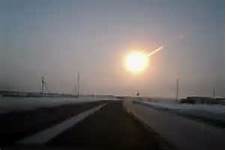 Seismograph stations supported by the National Science Foundation (NSF) to study earthquakes and the Earth’s deep interior observed spectacular signals from the Chelyabinsk meteor. While thousands of earthquakes from around the globe are recorded by seismometers of the permanent Global Seismographic Network (GSN) and EarthScope’s temporary Transportable Array (TA) each year, large meteorite impacts are far less common. However, the meteorite explosion on February 15 near Chelyabinsk, Russia, generated both ground motions and air pressure waves in the atmosphere. The ground motions were recorded by stations in the GSN and the TA, and the pressure waves were detected by special sensors that have been part of the TA station instrumentation for several years.
Seismograph stations supported by the National Science Foundation (NSF) to study earthquakes and the Earth’s deep interior observed spectacular signals from the Chelyabinsk meteor. While thousands of earthquakes from around the globe are recorded by seismometers of the permanent Global Seismographic Network (GSN) and EarthScope’s temporary Transportable Array (TA) each year, large meteorite impacts are far less common. However, the meteorite explosion on February 15 near Chelyabinsk, Russia, generated both ground motions and air pressure waves in the atmosphere. The ground motions were recorded by stations in the GSN and the TA, and the pressure waves were detected by special sensors that have been part of the TA station instrumentation for several years.
The Chelyabinsk meteor exploded in the atmosphere at approximately 03:20 GMT (9:20 AM local time) on February 15. The pressure wave from the blast caused significant damage in the city, breaking thousands of windows and injuring more than 1000 people. The energy from the blast created pressure waves in the atmosphere that rapidly moved outward from the terminal burst and spread around the globe. The downward directed blast coupled into the ground and spread outward as a seismic wave in the Earth. These two waves – the seismic wave in the Earth and the pressure wave in the atmosphere – travel at very different speeds. The waves in the ground travel quickly – at about 3.4 km per second – and attenuate rapidly, whereas the waves in the atmosphere are much slower (~0.3 km per second) and can travel great distances.
GSN stations in Russian and Kazakhstan show the ground-traveling wave as a strong, abrupt pulse with a duration of about 30 seconds (Figure 2 at http://dev.iris.edu/dms/nodes/dmc/specialevents/2013/02/19/chelyabinsk-russia-bolide-meteor).
The atmospheric waves – referred to as infrasound – are detected over a broad range of sub-audible frequencies and are observed at great distances on infrasound microphones. When the infrasound waves reached the eastern US, after traveling 8.5 hours through the atmosphere across the Arctic from the impact site in Russia, they were recorded at TA stations at the Canadian border. The infrasound waves reached Florida three hours later, nearly 12 hours after the blast. The spectacular TA recordings from the meteor (Figures 9-15 at http://dev.iris.edu/dms/nodes/dmc/specialevents/2013/02/19/chelyabinsk-russia-bolide-meteor) show complex signals in the frequency band 0.02 – 0.12 Hz lasting for almost an hour. There is some evidence of the infrasound wave producing strong enough ground vibration to also be recorded on the TA’s seismometers. Infrasound sensors at additional TA stations along the Pacific coast and in Alaska also recorded the blast (Figure 8 at http://dev.iris.edu/dms/nodes/dmc/specialevents/2013/02/19/chelyabinsk-russia-bolide-meteor), but with signatures that are shorter and simpler than that recorded by the stations located in the midcontinent and along the southeastern seaboard. The extended duration of the signals and the differences between the waveforms in the east and west are presumably related to the way in which the energy travels and bounces on its long path through the atmosphere. The exact reasons for the differences will be the subject of future studies that may reveal important new insights into the complex structure and mode of propagation in the stratosphere.
Complete IRIS Article (PDF)
IRIS Special Event page for the Chelyabinsk meteor
IRIS Teachable Moment for Chelyabinsk meteor
National Science Foundation Press Release
Information about the EarthScope Transportable Array
Information about the Global Seismographic Network